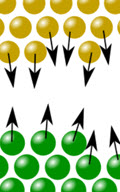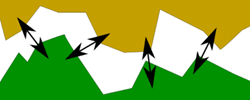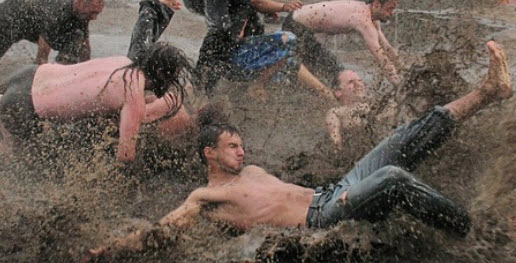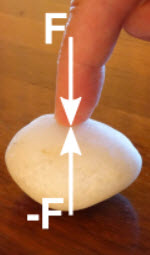Types of Force
Force is a push or pull.
4 Fundamental Forces
There are only four fundamental forces in the Universe.
| These two happen at the atomic level: | |
|
|
|
|
| And these two we experience every day: | |
|
|
|
|
Let's learn more about the last two.

Electromagnetic Forces
Contact forces, friction and air resistance are all due to electromagnetic interactions between atoms!
Electrons on one surface repel electrons on the other surface. This leads to contact force:

Friction is the force that pushes back when things try to slide past each other

Two rough surfaces trying to slide past each other.
Without friction we couldn't go anywhere!

A bit more friction, please!
But friction also causes wear and tear on mechanical equipment, so it is not always helpful.
Air resistance (also called drag) is a type of friction. It is greater at higher speeds.
Electromagnetic force includes both:
- Electric forces: like charges repel and unlike charges attract
- Magnetic forces: like poles repel and unlike poles attract (north and south)
Gravitational Force
Gravity is the attraction of objects with mass or energy towards each other.
It can, for example, make an apple fall to the ground:
Imagine you hold the apple. Gravity pulls the apple downward. The gravitational force on the apple is called its weight.
The apple pushes down on your hand, and your hand pushes back up on the apple with an equal-sized force.
Talking About Force
We use special words when talking about force:

Reaction Force: the force that pushes back when another force is applied.
Pushing on this stone gets a reaction force in return.
An Action Force gets a Reaction Force.
Those two forces are equal in size and opposite in direction, and they act on different objects.
Example: a car pushes down on the road, and the road pushes up on the car.
The weight of the car gets a reaction force from the road.
See Newton's 3rd Law.Force can be a push or pull:

Push

Pull
An object can be in tension or compression:

Tension

Compression
Tension or compression can be important! For example concrete is very strong in compression but breaks easily in tension, so they often put steel inside concrete to give it strength in tension.
A turning force (which is force times distance) is called a torque (or moment):

Moment or Torque
An object twisted by forces is in torsion:

Torsion (twisting)